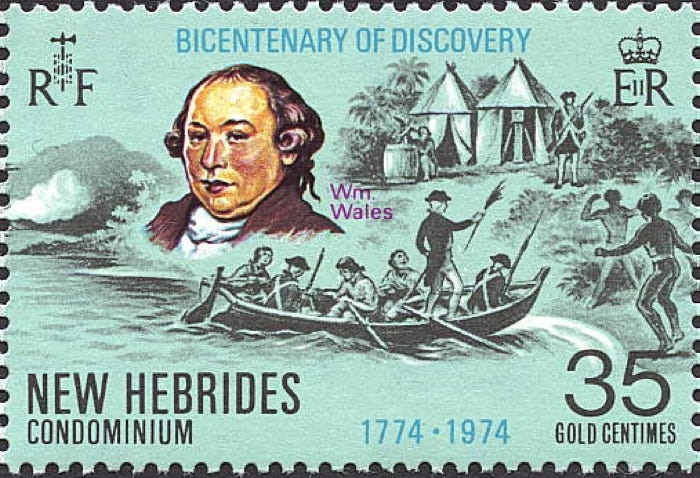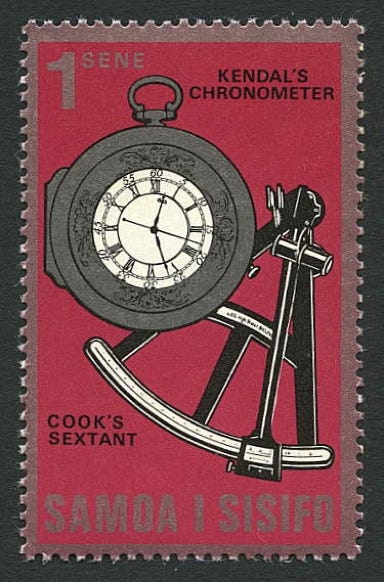William Wales

New Hebrides, 1974
William Wales (1734–98) was a British astronomer who sailed with Captain James Cook on his second voyage to the Pacific. Wales had been one of the first so-called ‘computers’ engaged on calculating navigation tables for the newly founded Nautical Almanac. He made his name in 1769 when he was sent by the Royal Society to Hudson’s Bay in Canada to observe the transit of Venus, which was simultaneously observed from Tahiti by Cook and Charles Green. (Incidentally, while at Hudson’s Bay Wales initiated regular meteorological observations which Canada commemorated on a stamp in 1968, although without mentioning his name.)
Green died on the return from Tahiti. Wales, who was married to Green’s sister, replaced him on Cook’s second voyage in 1772–75. A subsidiary aim of this voyage was to test the reliability of Larcum Kendall’s copy of John Harrison’s chronometer H4 (see the 1970 stamp from Samoa below). It passed the test with glowing endorsements from Cook and Wales.
The above stamp is the central member of a strip of three from the New Hebrides islands (now known as Vanuatu) commemorating their discovery by Cook. The stamp shows Cook’s landing party coming ashore, with Cook holding out a palm frond to the natives to indicate his peaceful intentions. In the background Wales is seen observing outside a tent with a telescope mounted on a barrel. In the adjoining tent, under armed guard, is a large observatory clock.
The depiction of Wales is apparently based on this portrait of him, now at Christ’s Hospital school where he became mathematical master on his return. The other two stamps in the strip show Cook and William Hodges, an artist who recorded scenes on the expedition.
Stanley Gibbons no. 193

Kendall’s chronometer and Cook’s sextant
(Samoa 1970)

An accurate source of time is essential for finding longitude at sea, but no clock was good enough until the Englishman John Harrison produced a revolutionary chronometer in 1760 known as H4. Larcum Kendall, a British clockmaker, was commissioned by the Board of Longitude to build a copy of H4 which was tested on Captain Cook’s second voyage to the Pacific in 1772–75. William Wales was appointed by the Board of Longitude to oversee the trial, which the timepiece passed with flying colours. Kendall’s chronometer, known as K1, is shown alongside Cook’s sextant on this stamp from Samoa (which mis-spells the surname as ‘Kendal’).
It is part of a set of four issued by Samoa as a bicentenary tribute to Cook’s first voyage of Pacific exploration. Other stamps in the set show Cook’s statue at Whitby, Yorkshire; a profile of Cook; and Cook with HMS Endeavour, his original ship. The border of the stamp and some of the lettering is printed in silver and does not show up well on this scan.
Stanley Gibbons no. 349

Portable observatory (St Helena, 1979)
A portable observatory of the type used by William Wales, as carried on Cook’s second and third voyages. Instruments and clocks were kept in a canvas tent supported by wooden poles, but celestial observations were mostly made in the open air. The tent shown here contains a pendulum regulator clock by John Shelton firmly supported in a wooden frame. One of the original clocks used on those voyages can still be seen in the library at the Royal Society in London.
This stamp is part of a set of four issued by St Helena on the bicentenary of Cook’s death in 1979.
Stanley Gibbons no. 348